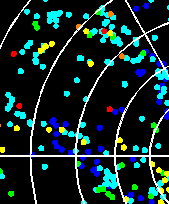

HIPASS Bright Galaxy Catalog
Bärbel Koribalski (ATNF)
+ HIPASS and ZOA teams
Histograms of the HI brightest galaxies in the southern sky
The HI properties shown below have been measured with the miriad program
mbspect assuming a point source model (FWHM = 15.5 arcmin).
About 100 sources,
particularly the nearby galaxies, are extended and will be re-measured asap.
The total number of sources in the current catalog is 1237, incl. about
30 HVCs, several galaxy groups and many galaxy pairs. About 100 sources have
not previously been cataloged, most of which are in the Zone-of-Avoidance or
close to bright stars (see also Henning et al. 2000).
Figure 2a: HI peak flux histogram.
Displayed here are the HI peak fluxes of all sources up to 0.7 Jy/beam (bins
are 10 mJy/beam). There are 66 sources with larger peak fluxes, ranging from
0.7 to 24 Jy/beam. The brightest 1000 sources have peak fluxes larger than 120
mJy/beam, which appears to be the completness limit of this catalog. ---
The largest HI peak flux measured is that of NGC6822 (24 Jy/beam),
followed by IC1613 (13 Jy/beam), NGC0055 (9.4 Jy/beam), NGC3109, NGC0300, WLM,
Sextans A, NGC5236, NGC0247, ESO214-G017, NGC3621, NGC1313, Circinus,
NGC6744, NGC0253 (2.1 Jy/beam), ...

Figure 2b: Total HI flux histogram (robust 0. moment).
Displayed here are the total HI fluxes of all sources up to 100 Jy km/s (bins
are 2 Jy km/s). There are 54 sources with larger total fluxes, ranging from
100 to 830 Jy km/s. ---
The largest total HI flux measured is that of NGC0300 (830 Jy km/s),
followed by NGC3109 (700 Jy km/s), NGC3621, NGC6744, NGC5236, NGC0253,
Circinus,NGC0247, NGC1313, IC1613, ...

Figure 2c: Histogram of systemic velocities (robust 1. moment).
Displayed here are the HI systemic velocities of all sources from -300 to
+8000 km/s (bins are 100 km/s). The first peak at 300-400 km/s is mostly
due to HVCs. ---
The highest HI systemic velocity measured is that of ESO327-G02 (7380 km/s),
followed by ESO264-G031/2 (6900 km/s), ESO441-G005 (6470 km/s), ESO529-G003
(5950 km/s), ...

Figure 2d: Histogram of velocity dispersions (robust 2. moment).
Displayed here are the HI velocity dispersions of all sources up to 230 km/s
(bins are 5 km/s). ---
The highest HI velocity dispersion measured is that of NGC5084 (191 km/s),
followed by NGC2613 (182 km/s), HIZSS084 (173 km/s), ESO240-G011 (170 km/s),
NGC7184 (167 km/s), ....

Figure 2e: Histogram of 50% velocity widths.
Displayed here are the HI 50% velocity widths of all sources up to 860 km/s
(bins are 10 km/s). The first bin shows the number of sources for which no
50% width measurement has been obtained so far. ---
The highest HI 50% velocity width measured is that of NGC5084 (640 km/s),
followed by HIZSS084 (600 km/s, group ?),
NGC2613 (595 km/s ), ESO240-G011 (542 km/s), NGC7184 (515 km/s), ....

Figure 2f: Histogram of 20% velocity widths.
Displayed here are the HI 20% velocity widths of all sources up to 860 km/s
(bins are 10 km/s). The first bin shows the number of sources for which no
20% width measurement has been obtained so far. ---
The highest HI 20% velocity width measured is that of HIZSS084 (720 km/s,
group?), followed by NGC5084 (695 km/s), CCF97-G6 (655 km/s, confused with
NGC5084 ?), NGC3673 (654 km/s ), ....
ESO576-G040 (currently 840 km/s) needs to be re-measrured as it is confused
with NGC5084.










